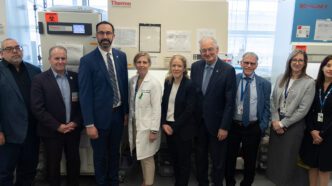Physician burnout and patient frustration are deeply linked in today’s healthcare system. At The Ottawa Hospital (TOH), both challenges are being tackled head-on with AI. By integrating Microsoft’s DAX Copilot, powered by ambient voice capture, TOH has seen remarkable results: seven minutes saved per patient encounter, a 70% drop in reported physician fatigue, and 97% of patients saying their visit felt better or just as good as before.
For hospital leaders like Glen Kearns, EVP and CIO of TOH, the real power of this AI tool lies in its ability to increase capacity without increasing hours. Just a few more patients seen per shift adds up fast — across ten physicians and 365 days, it dramatically boosts access to care.
TOH was Canada’s first hospital to test Microsoft’s DAX Copilot, which is now bundled with Dragon Medical One into a comprehensive AI assistant called Dragon Copilot. This tool connects directly with Epic, one of the most widely used electronic health records (EHR) platforms. During a visit, doctors can simply tap record on a mobile app, speak naturally with patients, and let the AI do the heavy lifting.
Instead of scribbling notes or typing while talking, physicians focus on the patient. In the background, the AI captures the entire conversation, pulls out relevant clinical data — symptoms, diagnosis, treatment plan — and drafts a structured clinical note. The doctor only needs to review and approve.
Microsoft’s system has been trained on a vast dataset of clinical knowledge and fine-tuned for different specialties, whether cardiology, dermatology, or emergency care. Feedback loops track how much a clinician edits the AI’s first draft, helping the model improve continuously. Over time, the less a note needs editing, the smarter the system becomes.
The result? Less after-hours work. Physicians no longer need to spend their evenings finalizing notes. According to Kearns, every category of physician at TOH now benefits from reduced documentation tasks, allowing them to end their shifts earlier and feel less drained.
The AI also helps lighten cognitive load during visits. Instead of navigating digital forms and searching for patient histories, clinicians can stay fully present. This shift has improved physician-patient engagement and boosted throughput — more patients seen per shift.
Importantly, TOH handles the ethical side with care. Every patient must give consent before recording, has access to the AI-generated notes through their MyChart portal, and is reassured about data security and privacy. That transparency has paid off — nearly all patients have responded positively, with 97% rating the experience equal to or better than past visits.
Looking ahead, Kearns sees even broader use cases. The AI could assist with identifying social determinants of health, triggering post-visit tasks like referrals or pre-authorizations, or even detecting biomarkers during a visit.
TOH isn’t stopping at documentation. The hospital is also deploying “digital teammates” to support both patients and staff. In partnership with Deloitte, they’ve created a multilingual avatar named Sophie. She doesn’t just talk — she observes. Sophie can detect sentiment and facial cues, helping interpret how a patient really feels, even if their words say otherwise.
Another avatar is on the way this spring, aimed at helping patients navigate their care journey and handle pre-screenings. These virtual agents are TOH’s answer to the global healthcare staffing crisis. By handling routine follow-ups and patient education, they free up nurses and doctors for tasks that truly require a human touch.
Kearns wants every patient, not just the highest-risk ones, to receive post-procedure follow-up. An avatar can check in on medication adherence, answer discharge questions, and escalate to a clinician if needed. This scalable support ensures patients never feel abandoned once they leave the hospital.
As Kearns puts it, AI is not replacing the human touch — it’s amplifying it. With AI ambient voice capture and digital teammates in place, The Ottawa Hospital is turning a reactive healthcare system into one that’s more proactive, efficient, and compassionate.













